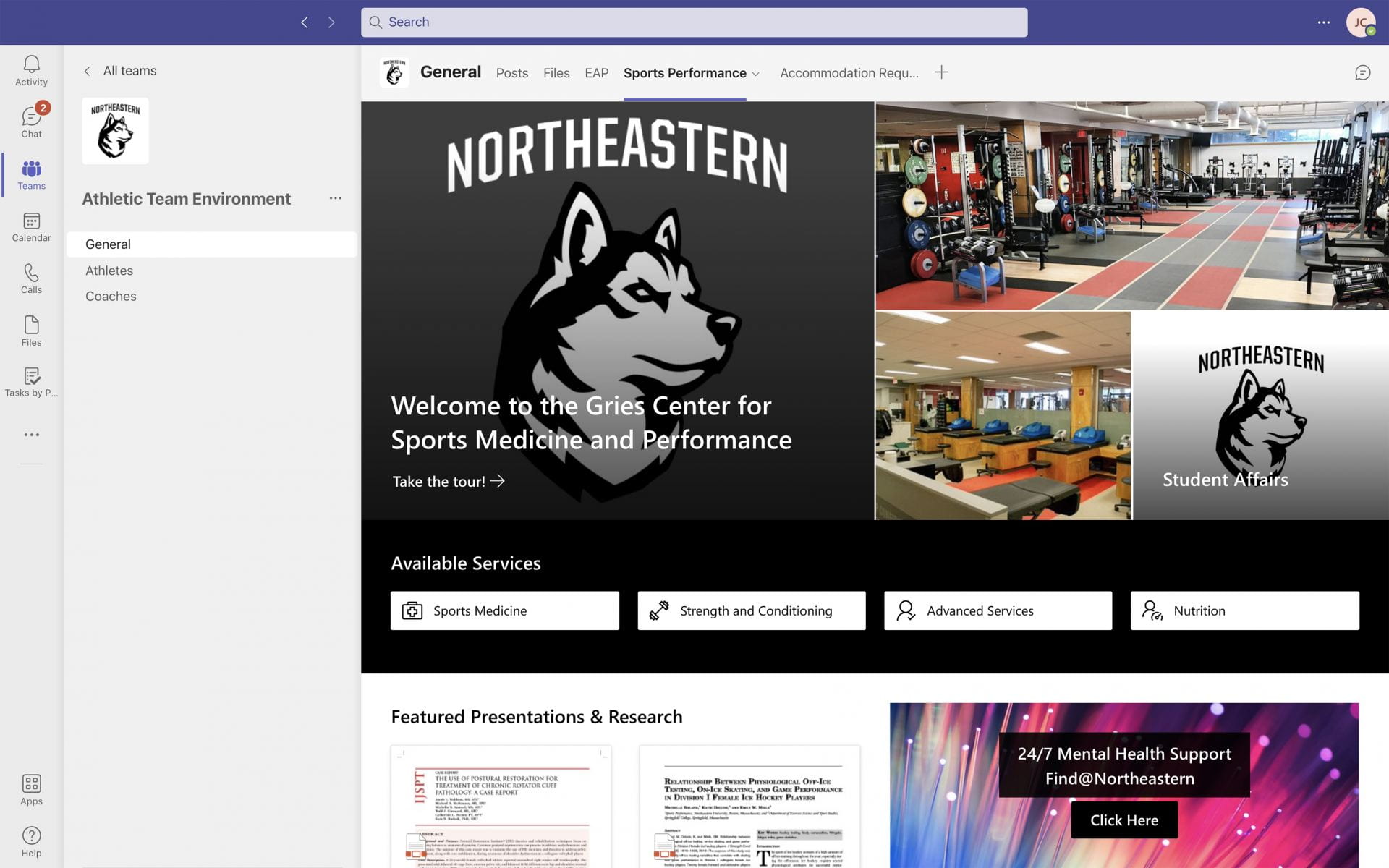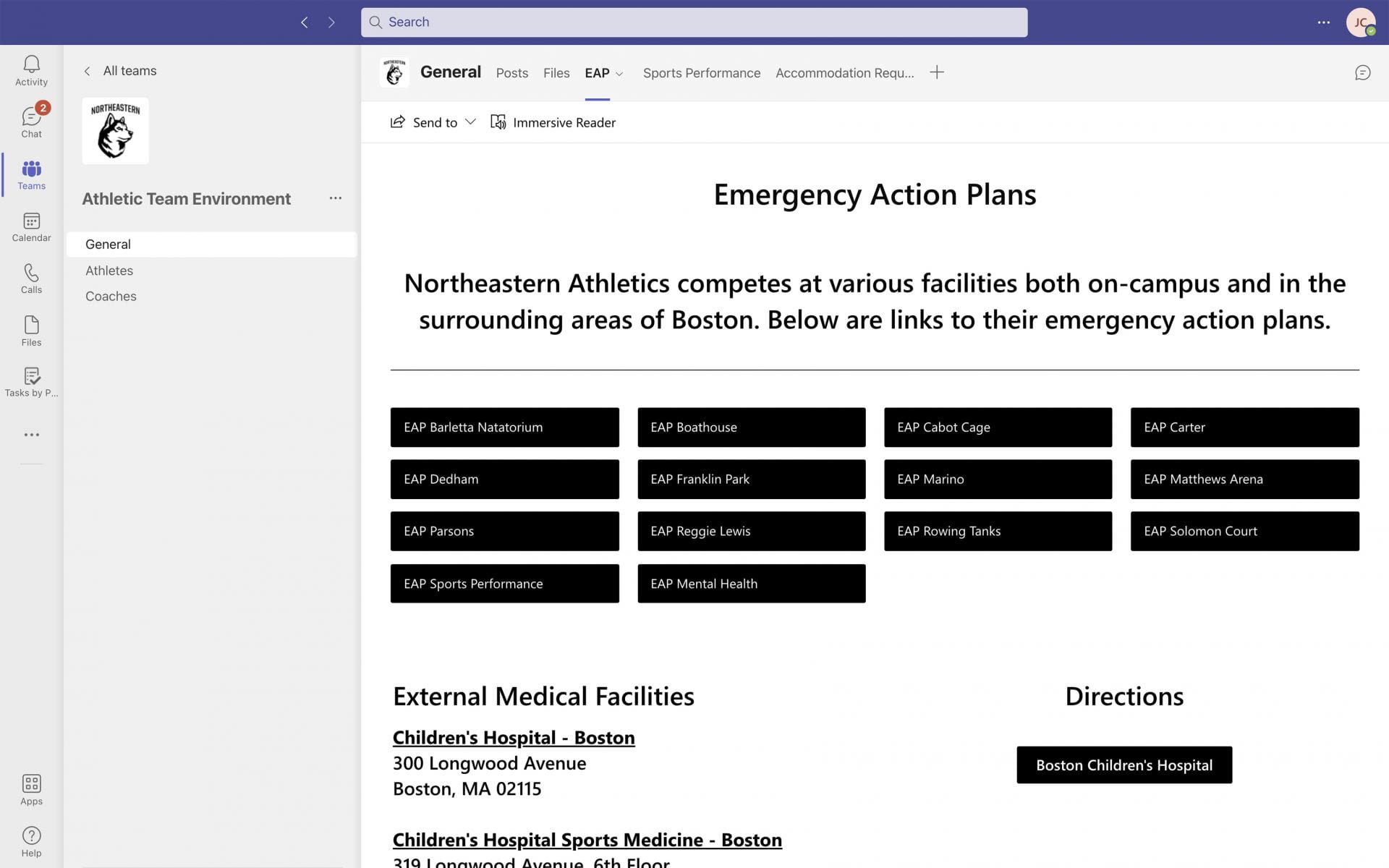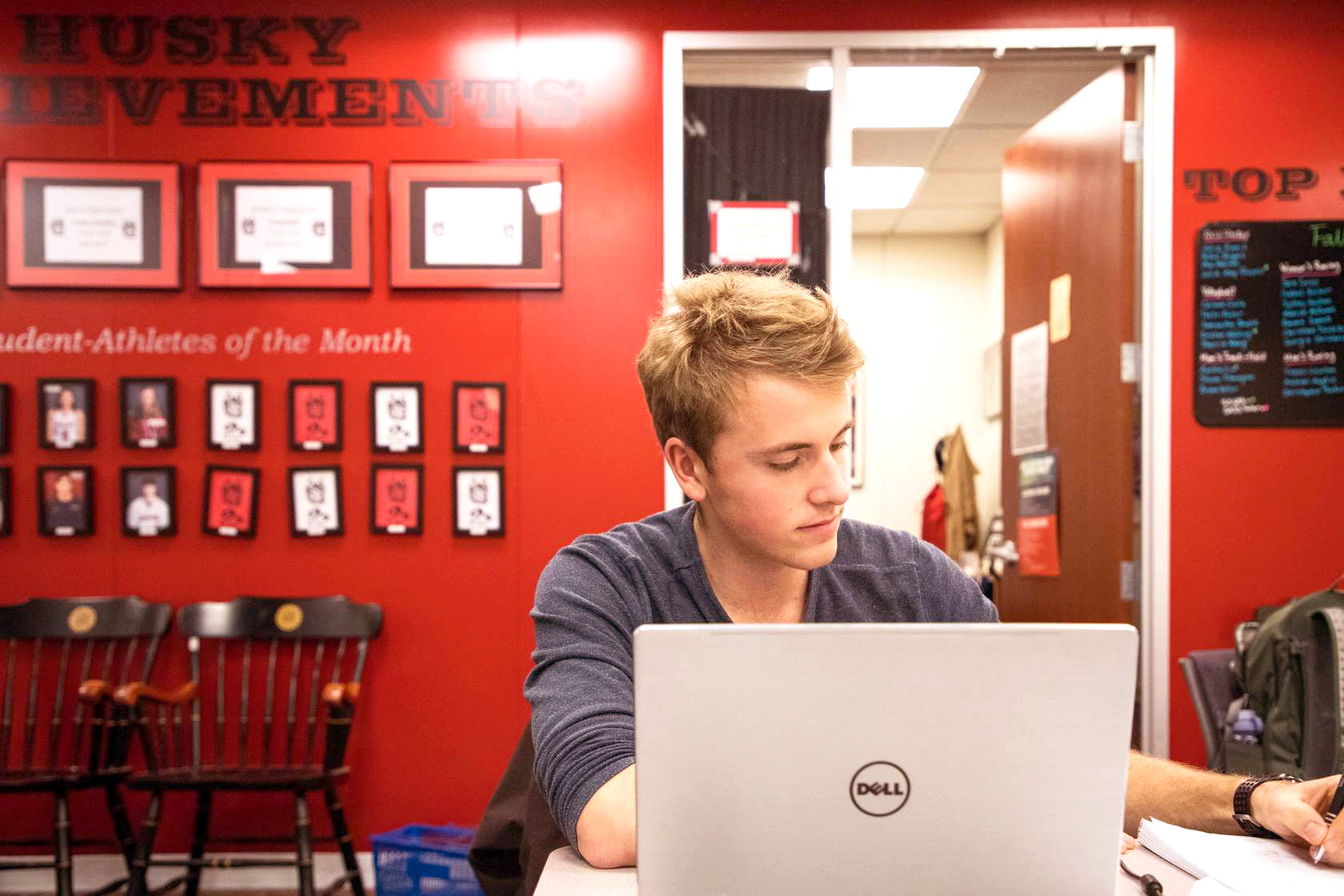Collaborative tools facilitate supporting and communicating with student-athletes, coaches, and staff
From recording accurate performance times to displaying box scores or screening replays, technology has long enhanced athletic endeavors. Not surprisingly, in higher education, technology provides athletics with much more than just competition support and data compilation.
Down two athletic trainers during the height of the pandemic, Mike McKenney, associate director of sports performance–medical compliance in Sports Performance, a unit within Student Affairs’ University Health and Counseling Services, fast-tracked the use of Microsoft 365 tools, specifically Microsoft Teams, across all of Athletics to streamline information sharing.
The end product is a scalable, centralized hub of easily accessed files, calendars, departmental projects, and interactions organized by project or area.
Designed to automate departmental tasks and solve usability issues that had undermined communications with and support of student-athletes, the interactive, responsive Teams workspace not only eliminated the need to train end-users in each Microsoft app, but also integrated seamlessly with department-issued mobile devices, essential for team travel and work at external sites.
“In May 2019, I started creating identical environments for all of our varsity sports teams because I needed a way to reach our student-athletes in their academic-technology world,” said McKenney, who oversees sports medicine services for Northeastern’s NCAA Division I athletes, serves as an athletic trainer and care coordinator for the men’s and women’s track and field program, and creates and manages digital solutions for the department. “In addition to simple files, we made Teams an access point for our department services, where coaches and athletes can seek self-guided information, book appointments for a number of different services, and submit information that triggers automated workflows and task assignment across our staff.”
As anticipated, the launch of the Teams environment energized engagement with coaches and athletes, improved overall user experience, and enhanced collaboration and connectivity within the department and across Athletics—an outcome that speaks to M365’s far-reaching capabilities and represents a genuine digital transformation at Northeastern.
I know I did a lot of this, but I would be remiss to say that Digital University Solutions did not help me along the way. I did not learn this all on my own.”
— MIKE MCKENNEY
Associate director of sports performance–medical compliance
While a Canvas course had already been built to reach athletes “in their environment,” a SharePoint site for the Gries Center for Sports Medicine and Performance, home to the Sports Performance program, was created to facilitate access to and for coaches, athletes, and administrators. McKenney also needed to collect data on departmental interactions and ensure that the solution supported growth. In the end, the SharePoint setup proved ideal for integration with Teams.
“My goal was to create a simplified access point to everything our department has to offer that was also integrated into the university technology suite and available tools … and to make the experience more interactive, automated, and responsive,” McKenney said. “Even early on, SharePoint provided this to an extent, but there were some barriers to adoption based on the tech literacy of our user base, as well as a limited mobile interface. In short, it had powerful tools that were difficult to use.”
On the other hand, the mobile-friendly Teams site—which is powered by SharePoint—closely resembles a website, presenting information in a familiar manner, with clear navigation, call-to-action buttons, distinct component blocks, and areas for messaging and real-time chat. Beyond its ease of use, the platform can accommodate growth as the department’s needs change and expand.

“I was surprised at how good Teams made SharePoint look to an end-user who wasn’t used to interacting with the service,” McKenney said. “A lot of the people I work with were turned off by SharePoint. Now, users are navigating SharePoint on a basic level since it opens and navigates within Teams, instead of sending them to an external app.”
To enhance user experience, McKenney created an identical Teams site for every varsity sports program. Each site features private channels, specifically for athletes and coaches, that provide relevant services, plans and programs, request forms, and submission outlets. These collaborative, cross-functional environments standardize communications, deploy automatic notifications, and improve record-keeping and data collection.
“We received feedback that email buries everyone a little bit. Our athletes and coaches live off notifications and app communications, not email communication, so that was a big push for us,” McKenney said.
For broader audiences, McKenney ensured that emergency action plans for each athletic facility were readily available to the university community via a page of hyperlinked buttons. Because the plans are attached as PDFs imported from SharePoint, they display in place and can be power-automated for quick distribution. Most importantly, users no longer need to access the forms on SharePoint.

“I was finding it very difficult to teach users how to navigate SharePoint,” McKenney explained. “I counted up to 10 clicks to get to these documents if the user was accessing SharePoint from a basic O365 login. Now, users can open up the Teams app, click on their team, and they’re there.”
Drawing from the COVID-19 protocols rolled out by the university during the pandemic, McKenney created a health guide and assignments in Canvas for all athletes. While the Canvas integration confirmed when each athlete had accessed and completed the assignments, the complete resource is also available on the Teams site.
SharePoint was also used to integrate a submission portal into the Teams installation, allowing coaches to submit practice schedules, travel plans, and game plans with just a few clicks. Once a schedule has been submitted, notifications are automatically sent to the appropriate stakeholders, including facility managers, to begin the evaluation process. While the documents can be opened in SharePoint or exported to Excel, McKenney plans to deploy Power Automate (formerly known as Flow) in the future to fully automate the approval process.
Teams also enables site sections to be built entirely from resources gleaned from other areas of the university. For instance, McKenney designed a page consisting entirely of educational handouts, social media feeds, videos, and other information created or shared by Student Affairs.

WHY USE MICROSOFT TEAMS?
“At its very core, Teams is a useful and easy way to collaborate and bring a department together in the digital space, but can be scaled for advanced users to be integrated in more-dynamic solutions.”
Mike McKenney
Associate director of sports performance–medical compliance
Because teaching stakeholders to use different technologies had been challenging, McKenney looked to Microsoft Forms to build a form that can be completed and delivered in Teams. Upon the form’s submission, a task is automatically created and assigned to the appropriate person, who is informed via a Teams task notification and a push notification on mobile. McKenney used Power Automate to establish the workflow and said that feedback to the form and notifications has been wholly positive.
Teams and its extensive functionalities “solved a really big problem for us, and it’s been really good,” McKenney said. “Our staff adopted the solution very quickly and enjoyed the messaging, file sharing, and automation that allowed them to spend time on other tasks.” As expected, users especially appreciated the mobile app, and feedback has been positive in response to the site’s transparency and the ease with which departmental services can be accessed.
McKenney is equally satisfied with the data returned by the software: “A simple Microsoft Form tells me how often people are making requests from our department, and it’s very straightforward.” In addition, Power BI furnishes metrics for appointments and staff shifts, for example, and SharePoint analytics measure site performance, which reveal considerable engagement.
“COVID gave us an opportunity to force people [to go] digital,” McKenney said. “I think this would have been more challenging in other circumstances. Because we went virtual, it forced their hand—and mine.”
On the heels of its successful implementation and use, McKenney’s scalable solution lines up with IT Services CIO Cole Camplese’s charge for Northeastern to embrace Microsoft’s collaborative platform—a crucial step in the journey to become a fully realized digital-first university.
Mike’s Quick-start Guide for Deploying Microsoft Teams
Training
“Contact IT Service’s Digital University Solutions team via a consultation for direct training on the software’s capabilities. I find that many people are eager for solutions like this, but they need to build awareness and see what can actually be done. From there, workflows can be evaluated to determine if or where a tool like Teams can be integrated.”
Workflows
“Identify key workflows for departmental functions, and write out every single step that is needed from the beginning to the completion of a given task. Use that information to identify where tools like MS Teams and the O365 suite can reduce the number of steps needed for success (or automate the process completely). This exercise will help guide you and the IT professionals you work with to create sustainable business solutions.”
Automation
“For the average user, most daily tasks are not looking at complex algorithmic functions to achieve a desired outcome. Rather, most of our daily administrative duties are linear in nature, which is something computers are very good at. This opens up a wide range of automation to increase efficiency once those steps are identified.”

